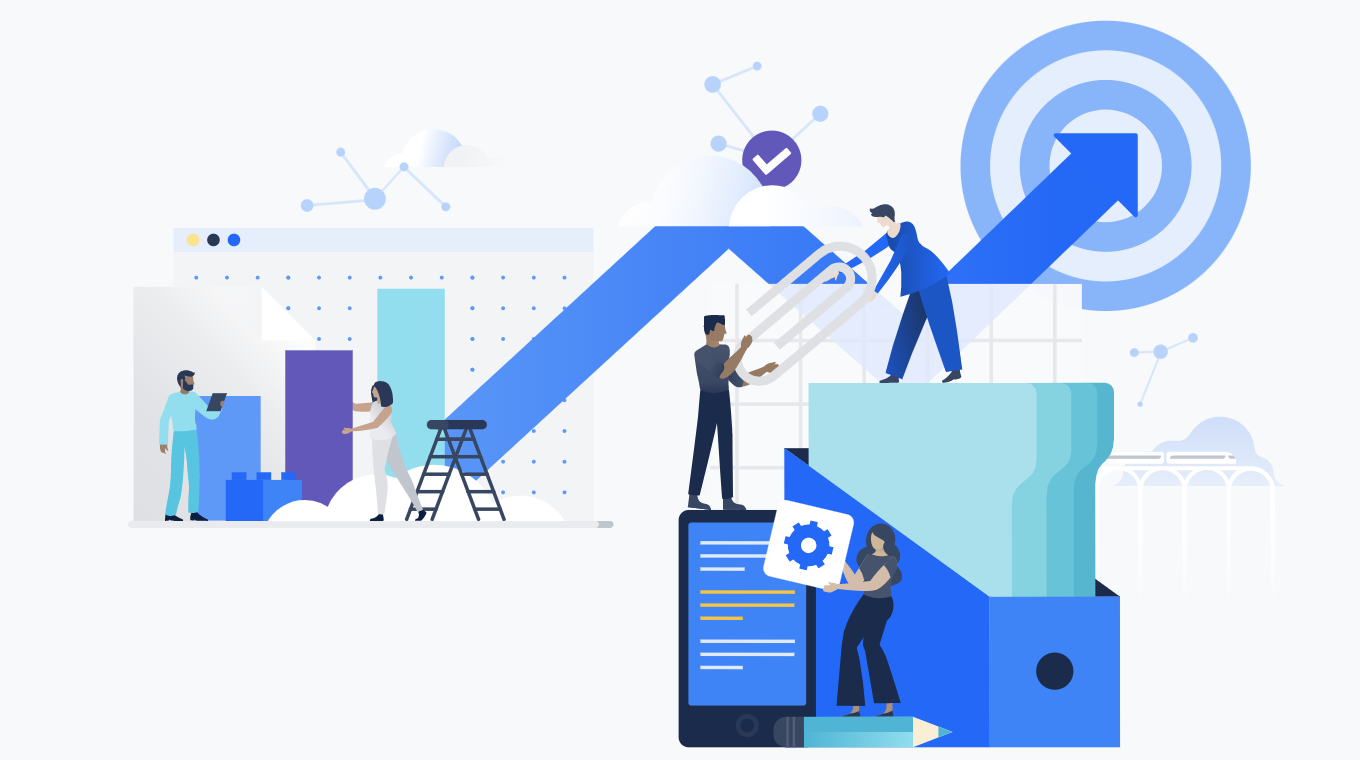Common scaling challenges for enterprises – and how cloud can help
Atlassian’s enterprise cloud, comprising our Cloud Premium and Cloud Enterprise plans, helps enterprises overcome common obstacles to drive growth.
Scaling challenges are often thought of as a startup problem, but they can be just as troubling for an enterprise. In fact, scaling is arguably more challenging for an enterprise, because its business model is less agile than that of a typical startup.
Enterprises have so many systems and processes in place, and navigating these processes often makes it difficult to drive any kind of growth. An enterprise also tends to have a higher employee count, which means that more people are impacted when the business makes a change. What’s more, an enterprise caters to a higher volume of customers and is responsible for protecting those customers’ data against cyber attacks. Any time the enterprise makes an adjustment to its business model, it has to make sure the change won’t negatively impact the security of this data.
Scaling is arguably more challenging for an enterprise because its business model is less agile than that of a typical startup.
These factors leave enterprises exposed to several risks when they attempt to scale: cultural changes, roadblocks that hinder productivity, and security vulnerabilities. If enterprises fail to address these scaling challenges, they jeopardize not only the success of new initiatives, but also the integrity of their organization as a whole.
Atlassian’s enterprise cloud, comprising our Cloud Premium and Cloud Enterprise plans, helps enterprises overcome these obstacles. Enterprises should move as many of their systems as possible to the cloud to avoid souring their culture, cluttering their servers, limiting productivity, and exposing data to security risks. Atlassian enterprise cloud makes it easy for enterprises to scale their cloud solutions alongside their business.
The challenge: lack of transparency sours your culture
A lack of transparency is one of the biggest threats a scaling enterprise will face. The bigger an organization or operation becomes, the more difficult it is to communicate with every stakeholder. As the org chart becomes more crowded, whether organically or through acquisitions, information flows tend to become haphazard, with some managers and teams sharing what needs to be known and others creating bottlenecks.
These bottlenecks and inconsistencies can be harmful to an enterprise’s culture. Employees want to know what their peers are working on and how their own work fits into the goals of the broader organization. Your culture is in jeopardy when they feel like they don’t.
Collaboration relies on a seamless flow of information
Collaboration is hard when you don’t know what your peers are working on. And if employees have to work in silos, they may end up feeling isolated and unmotivated, two issues that lead to employee turnover.
Trust breaks down when information flows are inconsistent
Teams become skeptical of their leaders when they routinely learn important information last minute or by accident. Information should flow through clear, systematic communications, so employees never feel blindsided.
There is no magic solution to overcoming this scaling challenge. Cloud can help enormously, however, by keeping information flowing freely between teams with minimal to no added effort.
Atlassian enterprise cloud plans improve cross-team visibility and culture
Cloud creates a single source of truth, giving teams a holistic view of what their organization and peers are working on. Everyone on the team gives and receives updates to/from one centralized location, and thus, information is always up to date. It’s also easy to see where workstreams overlap.
Cloud creates a single source of truth, giving teams a holistic view of what their organization and peers are working on.
Atlassian enterprise cloud plans have several features that are specifically designed to foster transparency, including Jira Premium and Confluence Premium.
With Jira Premium’s advanced roadmaps, IT teams can see what their peers are doing and how their work intersects and depends on each other. Confluence Premium’s analytics also keeps information flowing by providing reports on projects, teams, and content. In addition to providing transparency, these reports help enterprise leaders make smarter business and resourcing decisions.
Separately, Atlassian Cloud enhances collaboration by enabling continuous integration from any device. This means your developers can work in Jira or Bitbucket even when they’re on a mobile phone or tablet, and their code will still sync throughout the day. With this feature, your entire team can work confidently, knowing their code is in-line with a single source of truth.
The challenge: decentralized information slows productivity
Important documentation often gets lost as enterprises scale. Employees then waste time looking for what they need to do their jobs, and productivity declines.
Information is stored in silos or individual hard drives
How does information get lost? Important files often live on personal hard drives because employees save locally when they’re busy and forget to move their files to shared drives or update old versions. If an employee leaves the organization, that information is lost for good.
Naming conventions don’t exist
Even when employees do move documents to a shared drive, they often fail to follow the correct naming convention or manage version history so that it’s apparent which of their files are most up to date. This isn’t such a big deal when only a handful of employees are working together from one office, but when you have 100, 500, or 5,000 employees, it becomes a major scaling challenge.
Employees waste time seeking necessary data
The average employee spends nearly one full day per workweek looking for internal information or tracking down colleagues who can help with specific tasks, according to McKinsey. The larger you scale your organization, the more serious this problem becomes.
Again, enterprises face the inherent problem of “more” — more people, more files, more time zones, more time wasted just tracking down information. If two colleagues are working in time zones that are six hours apart, for example, it can take a whole day just for the two to connect. An avoidable problem, if only information were easy to find without a colleague’s help!
The average employee spends nearly one full day per workweek looking for internal information or tracking down colleagues who can help with specific tasks.
Atlassian Cloud centralizes information and boosts efficiency
Atlassian Cloud centralizes information, so important files live in a place where everyone can access them if given the right permissions. Cloud also autosaves in real time, ensuring information is always up to date.
Unlimited instances in the Cloud Enterprise plan make it easy for everyone in your organization to locate information across multiple cloud products. The simplest way to locate a file is to use the search function in Confluence. This feature will locate files in both personal and public spaces that match the user’s permissions settings.
Confluence Premium’s admin key and inspect permissions also give site admins more visibility and temporary access to restricted pages for permissions troubleshooting. This feature is essential when employees leave the company or when HR needs extra access for internal investigations.
Finally, Confluence and Jira’s archiving functionality reduces clutter and keeps sites up to date by archiving stale or outdated content and projects. By doing so, these features reduce the time spent looking for and sharing information.
The challenge: data is hard (and getting harder) to protect
Data protection is high on the list of scaling challenges. The larger an enterprise or operation becomes, the greater the volume of data the enterprise needs to protect, and the harder it is to protect it.
More people, more room for problems
More people and systems equate to more accounts, more passwords, and more room for human error. The risk of human error shouldn’t be taken lightly – according to the Harvard Business Review, it’s the leading cause of security breaches. Phishing attacks are one of the most common causes of data breaches, and these scams are largely a result of human error.
A growing threat landscape
A larger org chart exposes the enterprise’s data to an increasingly dangerous security threat landscape. Cyber attacks get more sophisticated every day as hackers find new vulnerabilities in a complex web of code and systems. The stakes are getting higher too. According to Accenture’s 2020 Cyber Threatscape Report, there was a 60 percent increase in the average ransom payment (US $178,254) between the first and second second quarters of 2020.”
Regulatory challenges
The compliance landscape will follow suit. New cyber threats mean new regulations around protecting data. And while necessary to mitigate risk, ensuring compliance with these rules will pose a massive scaling challenge for enterprises.
In sum, high volumes of data are exposed to high volumes of risk and have to be protected against high volumes of threats. Cloud mitigates these risks and threats by making it easier to adhere to regulations and keep data safe.
Atlassian Cloud makes security and compliance easier to manage
Cloud service providers allow enterprises to scale security and compliance operations across the organization with minimal effort. That’s because cloud service providers handle security and compliance upgrades for customers and roll these changes out on an ongoing basis.
Ninety-four percent of businesses claim that security improved when they moved to the cloud.
It’s no wonder 94 percent of businesses claim that security improved when they moved to the cloud, according to RapidScale.
Security, compliance, and governance are all built into Atlassian products. Atlassian Cloud provides all the most-requested security features, including but not limited to:
- Data encryption in transit and at rest
- Built-in disaster recovery
- SAML single sign-on (SSO) with all major portals
- User provisioning and de-provisioning through SCIM
- Enforced two-factor authentication
- API token controls
We also offer several additional enterprise-grade security features with Atlassian Guard, including:
- Multiple authentication policies
- Organization audit logs
- CASB integration with McAfee MVISION Cloud
- Organization insights
These features protect your business against security breaches without slowing down your users and allows administrators to manage data residency, so you can identify exactly where your data is hosted.
In addition to security features, Atlassian Cloud automatically meets all major compliance frameworks, so you never need to worry about whether your workstreams comply. Major frameworks include, but are not limited to, SOC 2, SOC 3, PCI-DSS, ISO/IEC 27001, ISO/IEC 27018, and GDPR.
We know security is an ongoing challenge for every business, so we perform proactive, rigorous security testing through threat-modeling, automated scanning, and annual third-party audits. We also operate a public bug bounty program through Bugcrowd so that our users can report any vulnerabilities they may identify as they work.
The challenge: tedious manual processes slow down your IT teams
Finding the IT resources needed to support enterprise growth is another common scaling challenge.
Growing teams require scarce IT time
New project members need access to the required technologies, which requires a good deal of manual labor. IT teams have to install each new server and load balancer, document processes, and approve hundreds of simple requests. Few IT teams have time for this. IT teams tend to be lean, and their services are already in high demand. Wasting time on account setups only exacerbates the problem.
Setup is inefficient and expensive
Even when there is staff available, demanding so much from IT for simple tasks like these is inefficient and expensive. IT talent isn’t cheap, and their time would be better spent on strategic initiatives or client-facing projects.
Moving more capabilities into the cloud allows you to onboard new employees faster and reduce your IT spend.
Atlassian Cloud automates routine tasks and frees up employee time
Cloud saves IT departments time mainly by eliminating the need for tech teams to buy, install, and update hardware when the business scales.
Security and performance updates occur automatically with the cloud, so IT doesn’t have to waste time facilitating these changes. Scaling and load-balancing also occur automatically. As enterprises add more users, compute capacity expands, preventing cloud systems from slowing down as businesses scale.
According to a survey of 58 Atlassian users by TechValidate, 97 percent of surveyed IT organizations said that Atlassian’s scalability is better compared to the competition.
With enterprise cloud, IT teams can automatically document processes, generate postmortem reports after an incident, preapprove standard changes, and flag code for peer review. They can also automate repetitive manual processes across multiple projects without writing a single line of code.
Ninety-seven percent of surveyed IT organizations said that Atlassian’s scalability is better compared to the competition.
Finally, IT teams can set up multiple instances in Atlassian enterprise cloud to easily customize environments, such as project workflow configurations or marketplace apps, based on individual team needs.
Overcome scaling challenges in the cloud
Your enterprise can avoid common scaling challenges by moving as many workstreams and files to the cloud as possible. Cloud will allow you to keep productivity high and data safe, all while maintaining a culture of transparency.
As you scale your enterprise, Atlassian Cloud Premium and Cloud Enterprise plans can help you scale your cloud service providers with it. Learn more by getting in touch with a member of our enterprise team.





